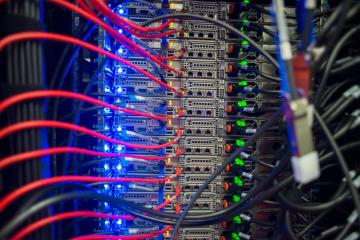Stanford's Data Center Earns National Recognition for Saving Energy

The Stanford Research Computing Facility (SRCF) uses nearly 40 percent less energy per square foot than the national median, prevents more than 1,300 metric tons of greenhouse gas emissions per year, and outperforms 100 percent of similar buildings nationwide.
Those are just a few of the energy-saving metrics that earned Stanford’s state-of-the art data center the U.S. Environmental Protection Agency’s ENERGY STAR certification for superior energy performance.
“Data centers are notorious for using lots of electrical energy to power the servers and storage,” said Phil Reese, a Stanford research computing strategist. “By being good shepherds of electrical use in the SRCF, we demonstrate our and Stanford’s commitment to saving energy and doing business as environmentally cleanly as possible.”
ENERGY STAR certified buildings and plants are verified to perform in the top 25 percent of buildings nationwide, based on weather-normalized source energy use that takes into account occupancy, hours of operation, and other key metrics.
“The SRCF demonstrates true environmental leadership by reducing harmful greenhouse gas emissions that are proven to contribute to climate change,” stated Jean Lupinacci, ENERGY STAR Director for Commercial and Industrial Buildings. “Today, 45 percent of U.S. emissions are attributable to commercial and industrial buildings, which is why improving energy efficiency is so critical for our future.”
A daily effort
At the SRCF, which hosts high-performance computing equipment for Stanford faculty and researchers, running such an energy efficient building is no accident.
It requires a daily review of the whole facility, looking for issues, leaks, rodents, security problems, and energy wasting situations. Scott Prevost, data center manager, is responsible for the onsite management and monitoring of the facility, which includes daily walk-throughs, inspection of system logs, and answering questions from system administrators, faculty, and others.
Each quarter, a team led by Ruth Marinshaw, the chief technology officer for Research Computing, meets to review how the building has performed and analyzes the up and down swings in the overall efficiency. They review information – displayed in charts and graphs – from a large data collection process that captures data points every five to 15 minutes 24 hours a day, seven days a week.
“Charts and graphs with this much data easily show where issues exist,” Reese said.
By the Numbers
- Cost to build the SRCF: More than $35 million
- Equipment housed in the SRCF: More than $35 million
- Frequency to replace equipment: About every 5 years
- Electricity charges: Over 25 years, the initial cost to build the SRCF ($35 million) will be spent on electricity charges
A lifetime of service
While the SRCF has been in use for four years, it has only just started its “lifetime of service” to the Stanford research community, said Reese. The building will continue to provide top notch data center services for another 25 years or more.
Since it opened in January 2014, the facility has served one of its main goals well, Reese added.
“It has allowed the campus to empty out some inefficient and unsecured equipment closets that were being used to host racks of servers and storage all across campus. There are more to empty, but the feedback has all been positive about the SRCF experience.”
Learn more
- Learn more about the Stanford Research Computing Facility on the Stanford Research Computing Center website.
- For more information about ENERGY STAR buildings, visit the ENERGY STAR website.
DISCLAIMER: UIT News is accurate on the publication date. We do not update information in past news items. We do make every effort to keep our service information pages up-to-date. Please search our service pages at uit.stanford.edu/search.



